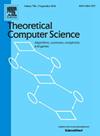使用随机场的几何覆盖
IF 1
4区 计算机科学
Q3 COMPUTER SCIENCE, THEORY & METHODS
引用次数: 0
摘要
如果有k1个半径为ε的球覆盖S,则向量S的一个集合(k1,ε)是可聚的;如果S中至少有k2个向量,且所有的对向距离都至少为δ,则向量S的一个集合(k2,δ)远非可聚的。我们提出了一种概率算法来区分这两种情况。我们的算法仅通过查看S上由随机场定义的标量值哈希函数的极值来做出决策;因此,它特别适用于分布式和在线设置。我们的方法的一个重要特征是,该算法对向量的数量是无关的:例如,在在线设置中,该算法仅存储常数数量的标量,这与流长度无关。我们引入随机场哈希函数,这是我们范例中的关键成分。随机场哈希函数推广了位置敏感哈希(LSH)。除了LSH要求“附近的向量被散列成相似的值”之外,我们的哈希函数还保证“对于远处的向量,散列值是(几乎)独立的随机变量”。我们制定了核的必要条件,这些核定义了应用于我们问题的随机场,以及核最优性的度量,我们提供了一个界。然后,我们提出了一种构造近似最优核的方法。本文章由计算机程序翻译,如有差异,请以英文原文为准。
Geometric covering using random fields
A set of vectors is -clusterable if there are balls of radius ε that cover S. A set of vectors is -far from being clusterable if there are at least vectors in S, with all pairwise distances at least δ. We propose a probabilistic algorithm to distinguish between these two cases. Our algorithm reaches a decision by only looking at the extreme values of a scalar valued hash function, defined by a random field, on S; hence, it is especially suitable in distributed and online settings. An important feature of our method is that the algorithm is oblivious to the number of vectors: in the online setting, for example, the algorithm stores only a constant number of scalars, which is independent of the stream length.
We introduce random field hash functions, which are a key ingredient in our paradigm. Random field hash functions generalize locality-sensitive hashing (LSH). In addition to the LSH requirement that “nearby vectors are hashed to similar values”, our hash function also guarantees that the “hash values are (nearly) independent random variables for distant vectors”. We formulate necessary conditions for the kernels which define the random fields applied to our problem, as well as a measure of kernel optimality, for which we provide a bound. Then, we propose a method to construct kernels which approximate the optimal one.
求助全文
通过发布文献求助,成功后即可免费获取论文全文。
去求助
来源期刊

Theoretical Computer Science
工程技术-计算机:理论方法
CiteScore
2.60
自引率
18.20%
发文量
471
审稿时长
12.6 months
期刊介绍:
Theoretical Computer Science is mathematical and abstract in spirit, but it derives its motivation from practical and everyday computation. Its aim is to understand the nature of computation and, as a consequence of this understanding, provide more efficient methodologies. All papers introducing or studying mathematical, logic and formal concepts and methods are welcome, provided that their motivation is clearly drawn from the field of computing.
 求助内容:
求助内容: 应助结果提醒方式:
应助结果提醒方式:


